Cornwall coast to coast (3 days- 51 miles).
I’d just ridden into work, when a colleague suggested, “you ought to ride the Camel trail, it’s the best cycle path in Britain.” Well I’ve heard that one before, but it needed investigating, so the plans were born to do the coast to coast Cornwall ride in September 2014.
Day 1- Looe to Polperro (6 miles)
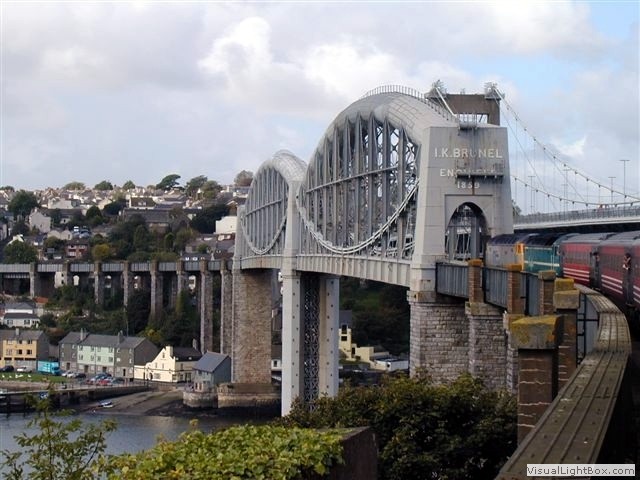 We booked a train from Newport to Looe, and I have to say the journey down was fantastic. At Exeter
the track follows the estuary then out along the south coast, hugging the beach to Dawlish Warren,
arguably one of the most scenic railway routes in the UK. We slowly crawl over the Royal Albert Bridge
crossing the river Tammar into Saltash, then on to Liskeard where we change for Looe. We stepped off the
train to very pleasant day, what great weather we were having so late in the summer. The Looe train
departs from platform three, but there isn’t a platform three? We decided running at the wall like in
the ‘Harry Potter’ film wasn’t a good idea. After some searching we discovered platform
three was up a ramp, and then across a road. We arrived there just in time to see our Looe train pulling
away into the distance. The ‘information button’ told us there was another train in an hour, so we had
nothing to do but go back the main station and have a cold drink.
We booked a train from Newport to Looe, and I have to say the journey down was fantastic. At Exeter
the track follows the estuary then out along the south coast, hugging the beach to Dawlish Warren,
arguably one of the most scenic railway routes in the UK. We slowly crawl over the Royal Albert Bridge
crossing the river Tammar into Saltash, then on to Liskeard where we change for Looe. We stepped off the
train to very pleasant day, what great weather we were having so late in the summer. The Looe train
departs from platform three, but there isn’t a platform three? We decided running at the wall like in
the ‘Harry Potter’ film wasn’t a good idea. After some searching we discovered platform
three was up a ramp, and then across a road. We arrived there just in time to see our Looe train pulling
away into the distance. The ‘information button’ told us there was another train in an hour, so we had
nothing to do but go back the main station and have a cold drink.
We arrived at Looe to an unimpressive little station, at least now we were on our bikes. Just along from the station is where East and West Looe rivers meet, making a natural lake of water, this is where we dipped the wheels. It’s tradition on a coast to coast to dip the rear wheel in the water at the start of the trek and the front wheel in drink at the final destination. Looe was once an important fishing village, and I can see the attraction of the place with its steep sides and panoramic views, it’s pretty, but like a lot of pretty places there’s often too many people and that changes the very character of what they came to see in the first place; a quaint fishing village, not a seaside town with more chip shops and ice cream parlours than Blackpool, and B&B’s on top of B&B’s. I couldn’t wait to get away from the place. We had an hour and a half to sunset and five miles to ride to Polperro where we were staying.
We crossed the river and rode up the most ridiculously steep road in the Universe heading for the South West Coastal path. These paths are primarily for walkers, not cyclists with laden bikes, but we were relatively new to touring and the route looked nice on the map. The path undulated up and down the coast making it impossible to ride and dropped down into Talland, a little beached cove with a cafe and a campsite, two miles away from Looe, but far away enough to be secluded. We had a cup of tea there before staggering up the next coastal path. It wasn’t long before we were dropping down into our final destination for the day; Polperro, another pretty fishing village.
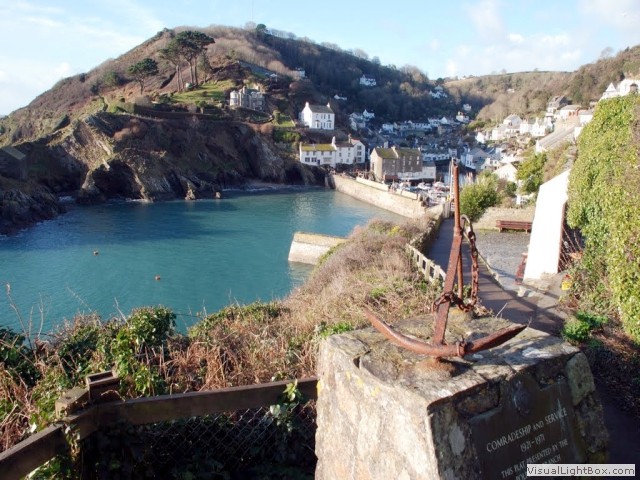 We rode straight to the front of our accommodation; The Old Mill Inn. We explained who we were and
the bar staff showed us where to put the bikes, then we sat and had a nice pint. The interior wouldn’t
be out of place in a smugglers film, very cosy with a real fire. After the second pint the owner came
over to us and explained there had been a mix up and in fact we didn’t have a room here. It seems a family
had block-booked the hotel and she had sent me an email last night. I explained I hadn’t seen any email, as
we wasn’t at home last night. I can see the business sense; fill the whole Inn or just a few rooms, we had
been trumped, but it wasn’t ethical. The manager explained she would try and find other rooms in the village
and she would give us 10% discount in the restaurant.
We rode straight to the front of our accommodation; The Old Mill Inn. We explained who we were and
the bar staff showed us where to put the bikes, then we sat and had a nice pint. The interior wouldn’t
be out of place in a smugglers film, very cosy with a real fire. After the second pint the owner came
over to us and explained there had been a mix up and in fact we didn’t have a room here. It seems a family
had block-booked the hotel and she had sent me an email last night. I explained I hadn’t seen any email, as
we wasn’t at home last night. I can see the business sense; fill the whole Inn or just a few rooms, we had
been trumped, but it wasn’t ethical. The manager explained she would try and find other rooms in the village
and she would give us 10% discount in the restaurant.
Not very happy we left our bikes here and walked to the next hotel, only 100 yards away, showered and changed we headed back to the Mill for food and beer. The food was nice, so everything worked out, but watch your bookings, I’ve never had this happen before, but I’ve heard of hotels doing it to others.
Day 2- Polperro to Padstow (31 miles)
After a small breakfast we retrieved the bikes from the Mill and plodded on, like Looe, Polperro is situated in a steep sided inlet. The only way out is by sea or climb, so up we went following the National Cycle Route 3. We turned left off the main road, up Kellow Hill, every so often we had to stop, not for the views, but to stop my Polar heart monitor beeping at me for going over my maximum HR. We followed the route through green fields, crossing the occasional brook, but nothing really much to comment on. We did a brief spell on the A390 and couldn’t wait to get back onto the small featureless lanes.
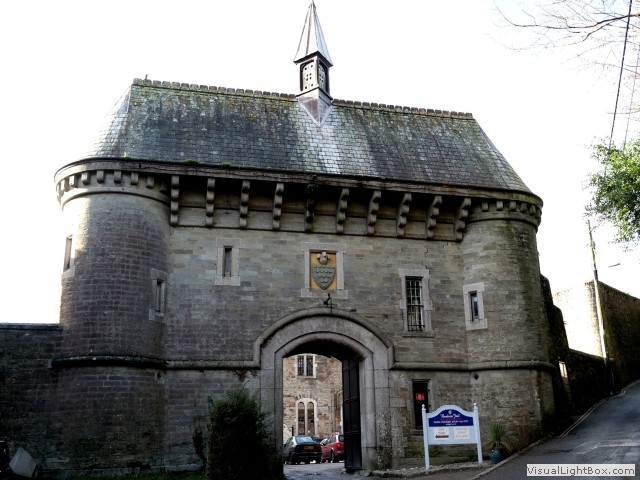 At last we arrived at Bomin jail, half way point, dinner and a pint, then a yomp around the jail. Bodmin
Gaol (old name for jail) was built in 1779 by prisoners from the American war of independence, and was
operational for 150 years, in which it saw over 50 public hangings. Entry price is £7.50. Step
away from the warmth of the restaurant and bar and it’s cold and damp. The Navel section has
primarily gone, only a shell remains, but the rest of the jail is still intact. There are three
floors to wander around, with plenty to see, most of the cells have manikins depicting a story
of a real inmate. It’s amazing to read some of the stories.
At last we arrived at Bomin jail, half way point, dinner and a pint, then a yomp around the jail. Bodmin
Gaol (old name for jail) was built in 1779 by prisoners from the American war of independence, and was
operational for 150 years, in which it saw over 50 public hangings. Entry price is £7.50. Step
away from the warmth of the restaurant and bar and it’s cold and damp. The Navel section has
primarily gone, only a shell remains, but the rest of the jail is still intact. There are three
floors to wander around, with plenty to see, most of the cells have manikins depicting a story
of a real inmate. It’s amazing to read some of the stories.
We changed back into our cycling shoes and basically turned right out of the jail and were on the Camel trail. The trail follows the paths of two former rail lines: the Bodmin and Wadebridge Railway from Wadebridge to Wenford Bridge, along with a short branch from that line to Bodmin and a section of the North Cornwall Railway between Padstow and Wadebridge. Within a mile or two we came across the Bodmin and Wenford heritage railway at Boscarne junction, which runs a little way along the trail. If you’re travelling by train, this railway has a platform at the mainline Bodmin Parkway station. There were no trains here when we arrived and eager to press on we left.
The trail has a fine gravel path and pass’s halt’s and platforms running along the camel river, it’s quite woody restricting the lateral views. We arrived at Wadebridge and had a cup of coffee, from here the trail is broken for about two miles and goes through the streets of Wadebridge. We rode passed the old station, now it enjoys a second career as the Sir John Betjeman Centre for the elderly, which has a certain irony. On the other side of Wadebridge the trail begins again, and here is where it apparently starts for every man and his dog. The views now open up as soon as we go underneath the towering Torridge road bridge. This is the last leg to Padstow, and it’s nice. We don’t pretend to be very fast, but compared to the customers using the trail now, we are tour-de-France riders. It was full of five year olds wobbling along from side to side, impeding our progress, and I must confess; I had the urge to physically move them out of the way (maybe a swift sideways push would go un-noticed?), but we passed them easily when one of them fell off, stopping the whole bunch. Then out of a sense of retribution from the mini cyclists, I had a rear puncher and all the little ones rode back past us, jeering that they had at last passed someone.
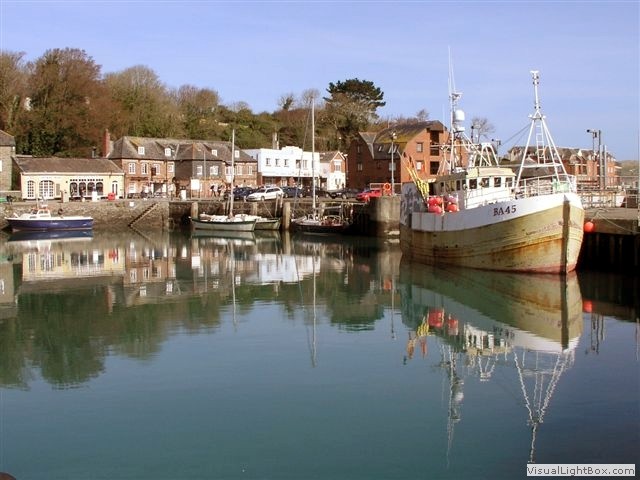 We eventually reach Padstow and if I thought the Camel trail was crowded, I was totally wrong.
Padstow was teaming with tourists eating chips and licking ice cream (just like where we started from).
We had a debate about dipping the front wheel here and decided to do it as this was the true ‘other
coast’, we were only going to Newquay because there wasn’t a train station here (any more). We headed up to the
hotel; The Cross House Hotel, and went in, there was no-one at the reception, then we noticed a sign
saying please ring for assistance. We picked up the phone and dialled the number, ‘I’ll be right there,
make yourselves at home.’ Twenty minutes later a dishevelled man arrived and we book in, it turns out no staff stay
at the hotel, this chap is a maintenance guy fleeting around the town to different premises. In fairness the
room was nice, but there were no towels, luckily Bob the builder hadn’t left and corrected this. I felt oddly
vulnerable about having a permanently open front door, with no staff to confront any would be
wrongdoer. There was one more thing; when I booked, I asked if there was somewhere safe to store
the bikes. I was told; yes, however there wasn’t. We were told to just lock the bikes against the
railings outside, I was not happy about this.
We eventually reach Padstow and if I thought the Camel trail was crowded, I was totally wrong.
Padstow was teaming with tourists eating chips and licking ice cream (just like where we started from).
We had a debate about dipping the front wheel here and decided to do it as this was the true ‘other
coast’, we were only going to Newquay because there wasn’t a train station here (any more). We headed up to the
hotel; The Cross House Hotel, and went in, there was no-one at the reception, then we noticed a sign
saying please ring for assistance. We picked up the phone and dialled the number, ‘I’ll be right there,
make yourselves at home.’ Twenty minutes later a dishevelled man arrived and we book in, it turns out no staff stay
at the hotel, this chap is a maintenance guy fleeting around the town to different premises. In fairness the
room was nice, but there were no towels, luckily Bob the builder hadn’t left and corrected this. I felt oddly
vulnerable about having a permanently open front door, with no staff to confront any would be
wrongdoer. There was one more thing; when I booked, I asked if there was somewhere safe to store
the bikes. I was told; yes, however there wasn’t. We were told to just lock the bikes against the
railings outside, I was not happy about this.
We changed and went for a walk around the town, dramatically there had been a peopletectomy (surgical removal of people). It turns out the majority of the tourists arrive on a coach and depart the same way early evening. We strolled around and went into a pub with a sign, two cod and chips for £10. We went in and ordered, only to be told the sign referred to pre-six o’clock. After some debate they agreed to give us what the sign had advertised, it’s a wonder some of these places even stay open, preying on the naivety of tourists. We finished grub and after bottle of wine bought from the ‘Spar’ supermarket, retired to the hotel and sat in the unattended front drawing room. During the night my bike alarm went off at 3am, I went down and brought the bikes inside and locked the front door.
Day 3- Padstow to Newquay (14 miles)
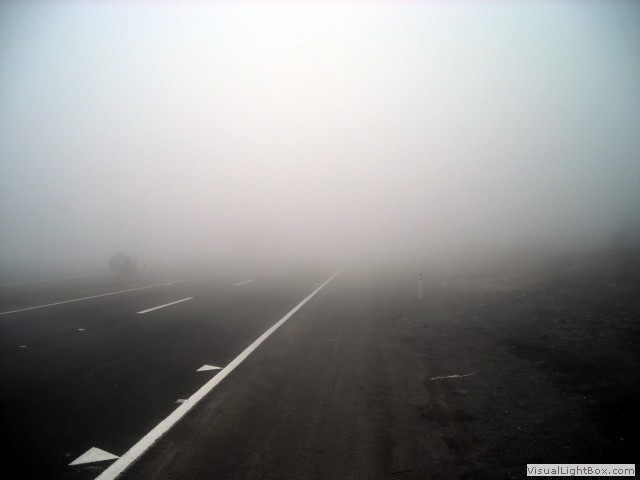 Morning came around with the greyness of a battleship, the weather had changed from blue
sky’s to drizzle. We had a small breakfast and set off, by this time the rain
was slightly heavier and was accompanied by mist, but (small mercies) there was no wind. All the
photos in the gallery from here are off the web as the images we took didn’t come out properly. On
the B3276 from Padstow the terrain profile looks like shark’s teeth, jagged, sharp, and up and
down. There was one particular tump of a hill we were climbing, a 4x4 vehicle reved his engine
behind us all the way up, until he passed us with a finger in the air. How rude!
Morning came around with the greyness of a battleship, the weather had changed from blue
sky’s to drizzle. We had a small breakfast and set off, by this time the rain
was slightly heavier and was accompanied by mist, but (small mercies) there was no wind. All the
photos in the gallery from here are off the web as the images we took didn’t come out properly. On
the B3276 from Padstow the terrain profile looks like shark’s teeth, jagged, sharp, and up and
down. There was one particular tump of a hill we were climbing, a 4x4 vehicle reved his engine
behind us all the way up, until he passed us with a finger in the air. How rude!
The beaches came thick and fast, the first was Harlyn bay, even in this weather there were surfers out on the water. We crossed the river Menalhyl near Mawgan Porth then up hill (don’t all of these names seem vaguely Welsh?). As soon as we went down, (slowly) we went back up, soon we were near Watergate bay hosting the Watergate Hotel (no, not the Nixon one) with rates of £300 per night and Jamie Olivers ‘fifteen’ restaurant. Past Portcothan bay and up a massive hill, but the views looking back are immense.
Once in Newquay we headed for the leisure centre (pre-arranged) and had a fantastic shower, we weren’t so much cold, as soggy. Then we headed for the ‘Great Western Hotel’ and had a bar meal and a few pints looking down on Tolcarne beach. It was great and a fitting end to the three days. Two hours later we made our way to the station just across the road. When the train arrived we were prevented from boarding by an overzealous conductor who asked us to remove our panniers from the bikes before they were allowed on. I wouldn't mind so much, but there was only three people on the train (and two of them was us!). In the years since, I’ve never been asked again.
I enjoyed the trip, very hilly, but good fun.
-
Gallery
 Why not have a look at the gallery relating to this ride. Click the image or the title.
Why not have a look at the gallery relating to this ride. Click the image or the title. -
Damage to the railway at Dawlish
 In early 2014, very strong winds and high seas severely damaged the railway line that runs
through Dawlish, washing away a section of the sea wall, platforms at Dawlish station and sections
of the coastal path. Leaving 80 metres of track suspended in mid-air. When this passage was out
of commission, other routes were ironically discussed, like the abandoned Okehampton-Tavistock-Plymouth
route. The main southwest line has since reopened after massive manpower was thrown at
it, it should be fully restored by Easter 2015.
In early 2014, very strong winds and high seas severely damaged the railway line that runs
through Dawlish, washing away a section of the sea wall, platforms at Dawlish station and sections
of the coastal path. Leaving 80 metres of track suspended in mid-air. When this passage was out
of commission, other routes were ironically discussed, like the abandoned Okehampton-Tavistock-Plymouth
route. The main southwest line has since reopened after massive manpower was thrown at
it, it should be fully restored by Easter 2015. -
H.M.S. Looe
 H.M.S. Looe was a 46 gun British Frigate, built on the Thames by Lime house Ship Builders. She was
launched on December 29, 1741, and was completed at Deftford. The wreck of the Looe was discovered
in 1950. Early treasure hunters recovered quite an assortment of artefacts from her, but no one has
ever located the ship she was towing. A Looe man is due to travel to Marathon in the Florida Keys this
year to lay a plaque next to the remains of the anchor of the fourth HMS Looe.
H.M.S. Looe was a 46 gun British Frigate, built on the Thames by Lime house Ship Builders. She was
launched on December 29, 1741, and was completed at Deftford. The wreck of the Looe was discovered
in 1950. Early treasure hunters recovered quite an assortment of artefacts from her, but no one has
ever located the ship she was towing. A Looe man is due to travel to Marathon in the Florida Keys this
year to lay a plaque next to the remains of the anchor of the fourth HMS Looe. -
Smuggling in Polperro
 Polperro's isolated position made it particularly difficult for the authorities to catch smugglers
in possession of contraband. Repeated efforts by Excise officers were often frustrated despite the
fact that a Customs Officer, Thomas Pinsent, was resident there for many years from 1766. Smuggled
goods were often landed at secluded coves along the coast near Polperro. Once on the beach, the
illicit goods would quickly disappear, hidden in caves or taken by well-trodden paths inland to
secret hiding-places.
Polperro's isolated position made it particularly difficult for the authorities to catch smugglers
in possession of contraband. Repeated efforts by Excise officers were often frustrated despite the
fact that a Customs Officer, Thomas Pinsent, was resident there for many years from 1766. Smuggled
goods were often landed at secluded coves along the coast near Polperro. Once on the beach, the
illicit goods would quickly disappear, hidden in caves or taken by well-trodden paths inland to
secret hiding-places. -
Respryn Bridge
 Respryn Bridge is a five arched medieval bridge spanning the River Fowey and has been dated to
1300. The bridge played an important part in the Civil War, lying as it did between the two major
estates of Lanhydrock and Boconnoc, one of Parliamentarian hand and the other a Royalist. King
Charles rode over the bridge in 1644, on his way from Boconnoc to Lanhydrock, and after the war,
the avenue of trees leading up to Lanhydrock House from Respryn Bridge was planted by Lord
Robartes to celebrate his party's victory.
Respryn Bridge is a five arched medieval bridge spanning the River Fowey and has been dated to
1300. The bridge played an important part in the Civil War, lying as it did between the two major
estates of Lanhydrock and Boconnoc, one of Parliamentarian hand and the other a Royalist. King
Charles rode over the bridge in 1644, on his way from Boconnoc to Lanhydrock, and after the war,
the avenue of trees leading up to Lanhydrock House from Respryn Bridge was planted by Lord
Robartes to celebrate his party's victory. -
The Bodmin County Lunatic Asylum
 The Bodmin County Lunatic Asylum is located on Boundary Road. During the span of 1840 to 1860
William Robert Hicks was the domestic superintendent of the Asylum. Allegedly the treatment of
inmates was appalling and he even found a patient chained in a dark cell marked as a dangerous
lunatic. The asylum was completely closed by 2003, but in 2011, a man was electrocuted and died
in the tunnels underneath the Asylum, they believe he was trying to steal the copper pipes from
inside the tunnels.
The Bodmin County Lunatic Asylum is located on Boundary Road. During the span of 1840 to 1860
William Robert Hicks was the domestic superintendent of the Asylum. Allegedly the treatment of
inmates was appalling and he even found a patient chained in a dark cell marked as a dangerous
lunatic. The asylum was completely closed by 2003, but in 2011, a man was electrocuted and died
in the tunnels underneath the Asylum, they believe he was trying to steal the copper pipes from
inside the tunnels. -
Sir John Betjeman
 Sir John Betjeman’s boyhood summer memories began aboard the Atlantic Coast Express from Waterloo to
Padstow, he became a big train buff. Betjeman (Poet Laureat 1972-1984) is considered instrumental
in helping to save St Pancras railway station, London. He called the plan to demolish St Pancras
a ‘criminal folly’. About it he wrote, "What a Londoner sees in his mind's eye is that cluster of
towers and pinnacles seen from Pentonville Hill and outlined against a foggy sunset, and the great
arc of Barlow's train shed gaping to devour incoming engines, and the sudden burst of exuberant
Gothic of the hotel seen from gloomy Judd Street."
Sir John Betjeman’s boyhood summer memories began aboard the Atlantic Coast Express from Waterloo to
Padstow, he became a big train buff. Betjeman (Poet Laureat 1972-1984) is considered instrumental
in helping to save St Pancras railway station, London. He called the plan to demolish St Pancras
a ‘criminal folly’. About it he wrote, "What a Londoner sees in his mind's eye is that cluster of
towers and pinnacles seen from Pentonville Hill and outlined against a foggy sunset, and the great
arc of Barlow's train shed gaping to devour incoming engines, and the sudden burst of exuberant
Gothic of the hotel seen from gloomy Judd Street." -
Michelin star
Padstow maybe synonymous for top chef; Rick Stein, who has his own Michelin stared restaurants around the World, but restaurant ‘Paul Ainsworth at Number 6’ with its head chef John Walton, has earned the town’s first ever Michelin star. You maybe surprised to know the Michelin stars are awarded to the restaurant not the chef. Number 6 was given the award and included in the 2013 guide.
-
RAF Memorial at St Eval
 The area around Padstow played an important role in the Second World War. RAF St Eval is near to
Padstow and in June 1940 it became a fighter command sector headquarters during the Battle of Britain.
Spitfires were posted here, and were joined by Hawker Hurricane and Bristol Blenheim fighters. The
station's aircraft took an active part in the conflict. The airfield was heavily bombed during the
war, so the fighters were moved. Much of the basic structure can still be seen, but many of the buildings
have gone. The airfield is currently a communication station.
The area around Padstow played an important role in the Second World War. RAF St Eval is near to
Padstow and in June 1940 it became a fighter command sector headquarters during the Battle of Britain.
Spitfires were posted here, and were joined by Hawker Hurricane and Bristol Blenheim fighters. The
station's aircraft took an active part in the conflict. The airfield was heavily bombed during the
war, so the fighters were moved. Much of the basic structure can still be seen, but many of the buildings
have gone. The airfield is currently a communication station. -
East Wheal Rose mine
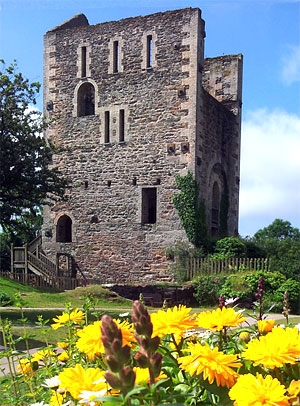 Silver is found in association with lead and several mines of this type existed in the Newquay area.
When Queen Mary (1553-1558) wanted silver to improve the countries coinage, Newquay, in the shape of
the Mountwise mine, became a very important source. For a quarter of a century it was very profitable,
eventually closing in 1864. A drainage adit runs from this mine, below Killacourt, to Towan beach. The
mine was used as a strategic water supply for the town by the Waterboard when they enclosed it in 1894.
Silver is found in association with lead and several mines of this type existed in the Newquay area.
When Queen Mary (1553-1558) wanted silver to improve the countries coinage, Newquay, in the shape of
the Mountwise mine, became a very important source. For a quarter of a century it was very profitable,
eventually closing in 1864. A drainage adit runs from this mine, below Killacourt, to Towan beach. The
mine was used as a strategic water supply for the town by the Waterboard when they enclosed it in 1894.

 In early 2014, very strong winds and high seas severely damaged the railway line that runs
through Dawlish, washing away a section of the sea wall, platforms at Dawlish station and sections
of the coastal path. Leaving 80 metres of track suspended in mid-air. When this passage was out
of commission, other routes were ironically discussed, like the abandoned Okehampton-Tavistock-Plymouth
route. The main southwest line has since reopened after massive manpower was thrown at
it, it should be fully restored by Easter 2015.
In early 2014, very strong winds and high seas severely damaged the railway line that runs
through Dawlish, washing away a section of the sea wall, platforms at Dawlish station and sections
of the coastal path. Leaving 80 metres of track suspended in mid-air. When this passage was out
of commission, other routes were ironically discussed, like the abandoned Okehampton-Tavistock-Plymouth
route. The main southwest line has since reopened after massive manpower was thrown at
it, it should be fully restored by Easter 2015.  H.M.S. Looe was a 46 gun British Frigate, built on the Thames by Lime house Ship Builders. She was
launched on December 29, 1741, and was completed at Deftford. The wreck of the Looe was discovered
in 1950. Early treasure hunters recovered quite an assortment of artefacts from her, but no one has
ever located the ship she was towing. A Looe man is due to travel to Marathon in the Florida Keys this
year to lay a plaque next to the remains of the anchor of the fourth HMS Looe.
H.M.S. Looe was a 46 gun British Frigate, built on the Thames by Lime house Ship Builders. She was
launched on December 29, 1741, and was completed at Deftford. The wreck of the Looe was discovered
in 1950. Early treasure hunters recovered quite an assortment of artefacts from her, but no one has
ever located the ship she was towing. A Looe man is due to travel to Marathon in the Florida Keys this
year to lay a plaque next to the remains of the anchor of the fourth HMS Looe. Polperro's isolated position made it particularly difficult for the authorities to catch smugglers
in possession of contraband. Repeated efforts by Excise officers were often frustrated despite the
fact that a Customs Officer, Thomas Pinsent, was resident there for many years from 1766. Smuggled
goods were often landed at secluded coves along the coast near Polperro. Once on the beach, the
illicit goods would quickly disappear, hidden in caves or taken by well-trodden paths inland to
secret hiding-places.
Polperro's isolated position made it particularly difficult for the authorities to catch smugglers
in possession of contraband. Repeated efforts by Excise officers were often frustrated despite the
fact that a Customs Officer, Thomas Pinsent, was resident there for many years from 1766. Smuggled
goods were often landed at secluded coves along the coast near Polperro. Once on the beach, the
illicit goods would quickly disappear, hidden in caves or taken by well-trodden paths inland to
secret hiding-places. Respryn Bridge is a five arched medieval bridge spanning the River Fowey and has been dated to
1300. The bridge played an important part in the Civil War, lying as it did between the two major
estates of Lanhydrock and Boconnoc, one of Parliamentarian hand and the other a Royalist. King
Charles rode over the bridge in 1644, on his way from Boconnoc to Lanhydrock, and after the war,
the avenue of trees leading up to Lanhydrock House from Respryn Bridge was planted by Lord
Robartes to celebrate his party's victory.
Respryn Bridge is a five arched medieval bridge spanning the River Fowey and has been dated to
1300. The bridge played an important part in the Civil War, lying as it did between the two major
estates of Lanhydrock and Boconnoc, one of Parliamentarian hand and the other a Royalist. King
Charles rode over the bridge in 1644, on his way from Boconnoc to Lanhydrock, and after the war,
the avenue of trees leading up to Lanhydrock House from Respryn Bridge was planted by Lord
Robartes to celebrate his party's victory. The Bodmin County Lunatic Asylum is located on Boundary Road. During the span of 1840 to 1860
William Robert Hicks was the domestic superintendent of the Asylum. Allegedly the treatment of
inmates was appalling and he even found a patient chained in a dark cell marked as a dangerous
lunatic. The asylum was completely closed by 2003, but in 2011, a man was electrocuted and died
in the tunnels underneath the Asylum, they believe he was trying to steal the copper pipes from
inside the tunnels.
The Bodmin County Lunatic Asylum is located on Boundary Road. During the span of 1840 to 1860
William Robert Hicks was the domestic superintendent of the Asylum. Allegedly the treatment of
inmates was appalling and he even found a patient chained in a dark cell marked as a dangerous
lunatic. The asylum was completely closed by 2003, but in 2011, a man was electrocuted and died
in the tunnels underneath the Asylum, they believe he was trying to steal the copper pipes from
inside the tunnels. Sir John Betjeman’s boyhood summer memories began aboard the Atlantic Coast Express from Waterloo to
Padstow, he became a big train buff. Betjeman (Poet Laureat 1972-1984) is considered instrumental
in helping to save St Pancras railway station, London. He called the plan to demolish St Pancras
a ‘criminal folly’. About it he wrote, "What a Londoner sees in his mind's eye is that cluster of
towers and pinnacles seen from Pentonville Hill and outlined against a foggy sunset, and the great
arc of Barlow's train shed gaping to devour incoming engines, and the sudden burst of exuberant
Gothic of the hotel seen from gloomy Judd Street."
Sir John Betjeman’s boyhood summer memories began aboard the Atlantic Coast Express from Waterloo to
Padstow, he became a big train buff. Betjeman (Poet Laureat 1972-1984) is considered instrumental
in helping to save St Pancras railway station, London. He called the plan to demolish St Pancras
a ‘criminal folly’. About it he wrote, "What a Londoner sees in his mind's eye is that cluster of
towers and pinnacles seen from Pentonville Hill and outlined against a foggy sunset, and the great
arc of Barlow's train shed gaping to devour incoming engines, and the sudden burst of exuberant
Gothic of the hotel seen from gloomy Judd Street." The area around Padstow played an important role in the Second World War. RAF St Eval is near to
Padstow and in June 1940 it became a fighter command sector headquarters during the Battle of Britain.
Spitfires were posted here, and were joined by Hawker Hurricane and Bristol Blenheim fighters. The
station's aircraft took an active part in the conflict. The airfield was heavily bombed during the
war, so the fighters were moved. Much of the basic structure can still be seen, but many of the buildings
have gone. The airfield is currently a communication station.
The area around Padstow played an important role in the Second World War. RAF St Eval is near to
Padstow and in June 1940 it became a fighter command sector headquarters during the Battle of Britain.
Spitfires were posted here, and were joined by Hawker Hurricane and Bristol Blenheim fighters. The
station's aircraft took an active part in the conflict. The airfield was heavily bombed during the
war, so the fighters were moved. Much of the basic structure can still be seen, but many of the buildings
have gone. The airfield is currently a communication station. Silver is found in association with lead and several mines of this type existed in the Newquay area.
When Queen Mary (1553-1558) wanted silver to improve the countries coinage, Newquay, in the shape of
the Mountwise mine, became a very important source. For a quarter of a century it was very profitable,
eventually closing in 1864. A drainage adit runs from this mine, below Killacourt, to Towan beach. The
mine was used as a strategic water supply for the town by the Waterboard when they enclosed it in 1894.
Silver is found in association with lead and several mines of this type existed in the Newquay area.
When Queen Mary (1553-1558) wanted silver to improve the countries coinage, Newquay, in the shape of
the Mountwise mine, became a very important source. For a quarter of a century it was very profitable,
eventually closing in 1864. A drainage adit runs from this mine, below Killacourt, to Towan beach. The
mine was used as a strategic water supply for the town by the Waterboard when they enclosed it in 1894.